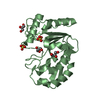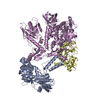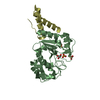[English] 日本語
 Yorodumi
Yorodumi- PDB-8q3r: Cryo-EM structure of the DNA polymerase holoenzyme E9-A20-D4 of v... -
+ Open data
Open data
- Basic information
Basic information
| Entry | Database: PDB / ID: 8q3r | ||||||||||||||||||||||||
|---|---|---|---|---|---|---|---|---|---|---|---|---|---|---|---|---|---|---|---|---|---|---|---|---|---|
| Title | Cryo-EM structure of the DNA polymerase holoenzyme E9-A20-D4 of vaccinia virus | ||||||||||||||||||||||||
 Components Components |
| ||||||||||||||||||||||||
 Keywords Keywords | VIRAL PROTEIN / DNA polymerase / holoenzyme / processivity factor / uracil-DNA glycosylase | ||||||||||||||||||||||||
| Function / homology |  Function and homology information Function and homology informationuracil-DNA glycosylase / uracil DNA N-glycosylase activity / viral DNA genome replication / Hydrolases; Acting on ester bonds; Exodeoxyribonucleases producing 5'-phosphomonoesters / DNA recombination / DNA-directed DNA polymerase / DNA-directed DNA polymerase activity / DNA replication / hydrolase activity / DNA repair ...uracil-DNA glycosylase / uracil DNA N-glycosylase activity / viral DNA genome replication / Hydrolases; Acting on ester bonds; Exodeoxyribonucleases producing 5'-phosphomonoesters / DNA recombination / DNA-directed DNA polymerase / DNA-directed DNA polymerase activity / DNA replication / hydrolase activity / DNA repair / nucleotide binding / DNA binding Similarity search - Function | ||||||||||||||||||||||||
| Biological species |  Vaccinia virus Copenhagen Vaccinia virus Copenhagen | ||||||||||||||||||||||||
| Method | ELECTRON MICROSCOPY / single particle reconstruction / cryo EM / Resolution: 3.8 Å | ||||||||||||||||||||||||
 Authors Authors | Burmeister, W.P. / Ballandras-Colas, A. / Boettcher, B. / Grimm, C. | ||||||||||||||||||||||||
| Funding support |  France, France,  United States, United States,  Germany, 7items Germany, 7items
| ||||||||||||||||||||||||
 Citation Citation |  Journal: PLoS Pathog / Year: 2024 Journal: PLoS Pathog / Year: 2024Title: Structure and flexibility of the DNA polymerase holoenzyme of vaccinia virus. Authors: Wim P Burmeister / Laetitia Boutin / Aurelia C Balestra / Henri Gröger / Allison Ballandras-Colas / Stephanie Hutin / Christian Kraft / Clemens Grimm / Bettina Böttcher / Utz Fischer / ...Authors: Wim P Burmeister / Laetitia Boutin / Aurelia C Balestra / Henri Gröger / Allison Ballandras-Colas / Stephanie Hutin / Christian Kraft / Clemens Grimm / Bettina Böttcher / Utz Fischer / Nicolas Tarbouriech / Frédéric Iseni /   Abstract: The year 2022 was marked by the mpox outbreak caused by the human monkeypox virus (MPXV), which is approximately 98% identical to the vaccinia virus (VACV) at the sequence level with regard to the ...The year 2022 was marked by the mpox outbreak caused by the human monkeypox virus (MPXV), which is approximately 98% identical to the vaccinia virus (VACV) at the sequence level with regard to the proteins involved in DNA replication. We present the production in the baculovirus-insect cell system of the VACV DNA polymerase holoenzyme, which consists of the E9 polymerase in combination with its co-factor, the A20-D4 heterodimer. This led to the 3.8 Å cryo-electron microscopy (cryo-EM) structure of the DNA-free form of the holoenzyme. The model of the holoenzyme was constructed from high-resolution structures of the components of the complex and the A20 structure predicted by AlphaFold 2. The structures do not change in the context of the holoenzyme compared to the previously determined crystal and NMR structures, but the E9 thumb domain became disordered. The E9-A20-D4 structure shows the same compact arrangement with D4 folded back on E9 as observed for the recently solved MPXV holoenzyme structures in the presence and the absence of bound DNA. A conserved interface between E9 and D4 is formed by a cluster of hydrophobic residues. Small-angle X-ray scattering data show that other, more open conformations of E9-A20-D4 without the E9-D4 contact exist in solution using the flexibility of two hinge regions in A20. Biolayer interferometry (BLI) showed that the E9-D4 interaction is indeed weak and transient in the absence of DNA although it is very important, as it has not been possible to obtain viable viruses carrying mutations of key residues within the E9-D4 interface. | ||||||||||||||||||||||||
| History |
|
- Structure visualization
Structure visualization
| Structure viewer | Molecule:  Molmil Molmil Jmol/JSmol Jmol/JSmol |
|---|
- Downloads & links
Downloads & links
- Download
Download
| PDBx/mmCIF format |  8q3r.cif.gz 8q3r.cif.gz | 335.3 KB | Display |  PDBx/mmCIF format PDBx/mmCIF format |
|---|---|---|---|---|
| PDB format |  pdb8q3r.ent.gz pdb8q3r.ent.gz | 217.6 KB | Display |  PDB format PDB format |
| PDBx/mmJSON format |  8q3r.json.gz 8q3r.json.gz | Tree view |  PDBx/mmJSON format PDBx/mmJSON format | |
| Others |  Other downloads Other downloads |
-Validation report
| Summary document |  8q3r_validation.pdf.gz 8q3r_validation.pdf.gz | 998.5 KB | Display |  wwPDB validaton report wwPDB validaton report |
|---|---|---|---|---|
| Full document |  8q3r_full_validation.pdf.gz 8q3r_full_validation.pdf.gz | 1 MB | Display | |
| Data in XML |  8q3r_validation.xml.gz 8q3r_validation.xml.gz | 57.1 KB | Display | |
| Data in CIF |  8q3r_validation.cif.gz 8q3r_validation.cif.gz | 84.8 KB | Display | |
| Arichive directory |  https://data.pdbj.org/pub/pdb/validation_reports/q3/8q3r https://data.pdbj.org/pub/pdb/validation_reports/q3/8q3r ftp://data.pdbj.org/pub/pdb/validation_reports/q3/8q3r ftp://data.pdbj.org/pub/pdb/validation_reports/q3/8q3r | HTTPS FTP |
-Related structure data
| Related structure data |  18134MC  8qamC M: map data used to model this data C: citing same article ( |
|---|---|
| Similar structure data | Similarity search - Function & homology  F&H Search F&H Search |
- Links
Links
- Assembly
Assembly
| Deposited unit | 
|
|---|---|
| 1 |
|
- Components
Components
| #1: Protein | Mass: 27468.379 Da / Num. of mol.: 1 Source method: isolated from a genetically manipulated source Details: D4 carries a N-terminal Strep-tag / Source: (gene. exp.)  Vaccinia virus Copenhagen / Gene: OPG116 / Cell line (production host): High Five / Production host: Vaccinia virus Copenhagen / Gene: OPG116 / Cell line (production host): High Five / Production host:  Trichoplusia ni (cabbage looper) / References: UniProt: P20536 Trichoplusia ni (cabbage looper) / References: UniProt: P20536 |
|---|---|
| #2: Protein | Mass: 49247.031 Da / Num. of mol.: 1 Source method: isolated from a genetically manipulated source Source: (gene. exp.)  Vaccinia virus Copenhagen / Gene: OPG148, A20R / Cell line (production host): High Five / Production host: Vaccinia virus Copenhagen / Gene: OPG148, A20R / Cell line (production host): High Five / Production host:  Trichoplusia ni (cabbage looper) / References: UniProt: P20995 Trichoplusia ni (cabbage looper) / References: UniProt: P20995 |
| #3: Protein | Mass: 120361.484 Da / Num. of mol.: 1 Source method: isolated from a genetically manipulated source Source: (gene. exp.)  Vaccinia virus Copenhagen / Gene: OPG071 / Cell line (production host): High Five / Production host: Vaccinia virus Copenhagen / Gene: OPG071 / Cell line (production host): High Five / Production host:  Trichoplusia ni (cabbage looper) / References: UniProt: P20509 Trichoplusia ni (cabbage looper) / References: UniProt: P20509 |
-Experimental details
-Experiment
| Experiment | Method: ELECTRON MICROSCOPY |
|---|---|
| EM experiment | Aggregation state: PARTICLE / 3D reconstruction method: single particle reconstruction |
- Sample preparation
Sample preparation
| Component | Name: E9-A20-D4 DNA polymerase holoenzyme / Type: COMPLEX / Details: heterotrimer / Entity ID: all / Source: RECOMBINANT | |||||||||||||||||||||||||
|---|---|---|---|---|---|---|---|---|---|---|---|---|---|---|---|---|---|---|---|---|---|---|---|---|---|---|
| Molecular weight | Value: 196.825 kDa/nm / Experimental value: NO | |||||||||||||||||||||||||
| Source (natural) | Organism:  Vaccinia virus / Strain: Copenhagen Vaccinia virus / Strain: Copenhagen | |||||||||||||||||||||||||
| Source (recombinant) | Organism:  Trichoplusia ni (cabbage looper) / Strain: High five Trichoplusia ni (cabbage looper) / Strain: High five | |||||||||||||||||||||||||
| Buffer solution | pH: 7.6 Details: 35 mM Tris-HCl, pH 8, 150 mM NaCl, 5 mM EDTA, 3.8 mM desthiobiotin | |||||||||||||||||||||||||
| Buffer component |
| |||||||||||||||||||||||||
| Specimen | Conc.: 1.3 mg/ml / Embedding applied: NO / Shadowing applied: NO / Staining applied: NO / Vitrification applied: YES | |||||||||||||||||||||||||
| Specimen support | Grid material: COPPER / Grid mesh size: 300 divisions/in. / Grid type: Quantifoil R1.2/1.3 | |||||||||||||||||||||||||
| Vitrification | Instrument: FEI VITROBOT MARK IV / Cryogen name: ETHANE / Humidity: 100 % / Chamber temperature: 277 K |
- Electron microscopy imaging
Electron microscopy imaging
| Experimental equipment |  Model: Titan Krios / Image courtesy: FEI Company |
|---|---|
| Microscopy | Model: TFS KRIOS |
| Electron gun | Electron source:  FIELD EMISSION GUN / Accelerating voltage: 300 kV / Illumination mode: FLOOD BEAM FIELD EMISSION GUN / Accelerating voltage: 300 kV / Illumination mode: FLOOD BEAM |
| Electron lens | Mode: BRIGHT FIELD / Nominal magnification: 42000 X / Nominal defocus max: 2400 nm / Nominal defocus min: 1400 nm / Cs: 2.7 mm |
| Specimen holder | Cryogen: NITROGEN |
| Image recording | Electron dose: 68 e/Å2 / Detector mode: COUNTING / Film or detector model: FEI FALCON III (4k x 4k) / Num. of grids imaged: 1 / Num. of real images: 1376 |
| Image scans | Width: 4096 / Height: 4096 |
- Processing
Processing
| EM software |
| ||||||||||||||||||||||||||||||||||||||||||||||||||
|---|---|---|---|---|---|---|---|---|---|---|---|---|---|---|---|---|---|---|---|---|---|---|---|---|---|---|---|---|---|---|---|---|---|---|---|---|---|---|---|---|---|---|---|---|---|---|---|---|---|---|---|
| CTF correction | Type: PHASE FLIPPING AND AMPLITUDE CORRECTION | ||||||||||||||||||||||||||||||||||||||||||||||||||
| Particle selection | Num. of particles selected: 381864 | ||||||||||||||||||||||||||||||||||||||||||||||||||
| Symmetry | Point symmetry: C1 (asymmetric) | ||||||||||||||||||||||||||||||||||||||||||||||||||
| 3D reconstruction | Resolution: 3.8 Å / Resolution method: FSC 0.143 CUT-OFF / Num. of particles: 104239 / Num. of class averages: 2 / Symmetry type: POINT | ||||||||||||||||||||||||||||||||||||||||||||||||||
| Atomic model building | Protocol: OTHER / Space: REAL / Details: Phenix real-space refinement | ||||||||||||||||||||||||||||||||||||||||||||||||||
| Atomic model building | 3D fitting-ID: 1 / Type: experimental model
| ||||||||||||||||||||||||||||||||||||||||||||||||||
| Refinement | Cross valid method: NONE Stereochemistry target values: GeoStd + Monomer Library + CDL v1.2 | ||||||||||||||||||||||||||||||||||||||||||||||||||
| Displacement parameters | Biso mean: 32.16 Å2 | ||||||||||||||||||||||||||||||||||||||||||||||||||
| Refine LS restraints |
|
 Movie
Movie Controller
Controller



 PDBj
PDBj




